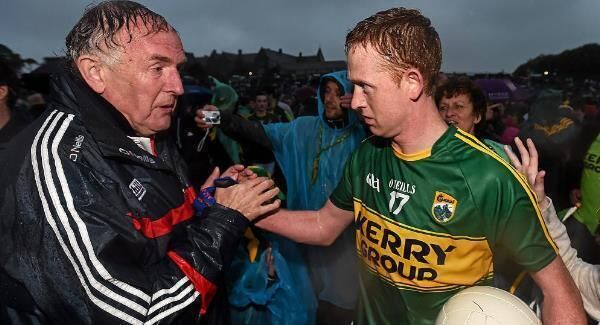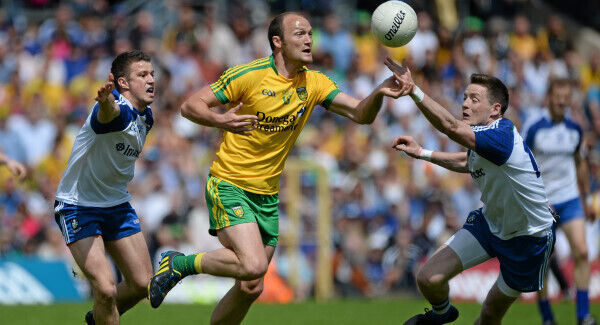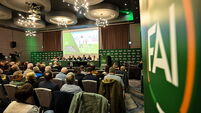Perfect timing all part of the mind games

1. WHEN TO COME OUT FOR THE SECOND HALF
In all the furore over Conor McCarthy’s article on Kerry’s subtle mastery of the grey arts, did any of the outraged notice or object to them taking 21 minutes to emerge for the second half last Saturday night?
Why did they take so long?
One, because they could; unlike in another high-scoring sport such as basketball where a similar violation results in a technical foul and two automatic free throws to the opposing team, there is no such deterrent in Gaelic games.
Secondly, we’re guessing, because they wanted to keep Cork waiting, especially in the monsoon that was outside those dressing room walls.

Like a number of things with Kerry, they didn’t start it, it really took off up North and Kerry just adapted and adopted it.
The Tyrone boys felt they got a great edge as well as later a great laugh out of holding back in the dressing room before the 2003 Ulster final replay while a drenched Down warmed up in the heavy shower outside. That was harmless enough, even if Ulster Council officials were hammering at the door; it was before the game, they would still be out in plenty of time for the parade, anthem and throw in.
But a couple of weeks later Armagh took it to another level, taking the Mo out of the momentum Micko’s Laois had gathered by keeping the Leinster champions out on the Croke Park field by themselves for five minutes before the start of their All-Ireland quarter-final second half.
Such subtleties like everything else about Armagh and Tyrone wouldn’t go unnoticed by Jim McGuinness. In 2012, his Donegal team would take it to an extreme, regularly going well over the allotted 15 minutes break that summer — with Kerry and Cork being among their waiting victims — to such an extent that as sport psych support to the Mayo team, I recommended in the final that we re emerge for the second half at the 17 and a half minute mark; that way, we’d be out neither too late nor too early.
Donegal were renowned for their third-quarter power push that summer — even if statistically Mayo’s third-quarter record was even superior that summer— and the sides would break even in that period before Donegal ran off three quick points between minutes 54 and 58. They would beat us for numerous reasons but one thing a Donegal management member would remark afterwards to us was how it wasn’t lost on them that their intentional tardiness hadn’t been lost on us.
Sometimes, of course, a team’s late reemergence can be innocuous. In 2013, I was also involved as a backroom member of Eamon O’Shea’s Tipperary and the side were five minutes late out for the second half of the league final against Kilkenny in Nowlan Park. No mind games were at work there; it was just the way Eamon’s half-time talk had spiralled.
But for the most part, any delay longer than three minutes is calculated. The opposing side hit the pitch with a certain — optimal — energy and focus. Leave them out on that field, standing around, often isolated, and that energy and focus is more likely to dissipate; meanwhile you’re still inside, the manager reinforcing the necessary message, raising the required energy before you hit the battleground running. It’s something that came up in conversation with rules revision chairman Jarlath Burns last month.
That if basketball can punish you with two free-throws, a 20-metre free-in would quickly have teams out a lot sooner in Gaelic games. Until then, the mind and waiting games will continue, and some will be better at it than others.
Cork, by the way, waited until the 20th minute themselves to come out last Saturday evening, and were only out a minute earlier, either aware or second-guessing what Kerry would be at.
But then Cork were the ones who had kept Kerry waiting in the drawn game and it wasn’t lost on Eamonn Fitzmaurice, who came out of the blocks for that second half.
Truly, between the pair of them, you wouldn’t be up to them.
2. WHEN ANNUAL JOANNE CANTWELL QUESTION WILL BE POPPED

We knew it was coming, months, years ago. She’s not alone in thinking it but no one quite as frequently as the RTÉ interviewer will put it to a Mayo or Dublin footballer after yet another provincial triumph:
Are they not concerned that they haven’t really been tested ahead of the All-Ireland series?
In another era, her thesis may have made considerable validity, but not now.
The most impressive outcome achievement of Mayo under James Horan wasn’t that they won four consecutive Connacht titles — it’s that they won four consecutive All Ireland quarter-finals in Croke Park — a place the county wasn’t previously renowned for winning regularly.
And look at who their quarter-final opponents were. In three of those years, they met the highest-available seed: Cork in 2011, Donegal in 2013, Cork again in 2014. The exception was Down in 2012, a team that contested the Ulster final. Donegal in 2013 were also Ulster runners-up. Considering Mayo beat both Ulster runners-up by an average of 15.5 points, you could retort to Joanne the Ulster championship clearly hadn’t steeled those teams for Mayo.
Dublin similarly thrashed last year’s Ulster runners-up, Monaghan, also bringing to four the number of consecutive times they’d backed up a provincial championship title with an All-Ireland quarter-final win. (The Joanne thesis is very similar to the one we’d hear years back that Dublin needed a strong Meath. Clearly Dublin haven’t been waiting around for Meath to emerge from the doldrums).

The paradox of it all is that in Ulster, you can be tested too often; last Sunday confirmed our suspicions that Donegal have been asked to hit too many peak dates to win both Ulster and Sam. But even a lot of years up North, the route to an Ulster final isn’t overly-demanding: this year Monaghan had to negotiate Cavan and Fermanagh, sides you’d think Dublin and Mayo would as well.
Here’s the reality: all the top teams get about one real severe test in their provinces. As for Dublin, that’s why Jim Gavin takes the league so seriously, just like Kilkenny have when Leinster hasn’t been at its strongest.
That’s the one place where the leading sides can be sure they’ll be tested before the August bank holiday weekend. It’s not Leinster, Munster, Connacht or even Ulster. It’s Division One. In the provinces, the competition is diluted. In Division One, it’s concentrated.
There’s another place where they know they’ll be tested: the training ground.
That’s where Mayo return now. Their next game will be against either Tyrone or Donegal, two counties they’ve overcome after winning Connacht and enduring Joanne’s annual question. But in this year’s league, Mayo couldn’t beat either team, even with home advantage. How they cope with the massed defence and hone a defence of their own is the real question now, not whether Galway tested them enough in Connacht.
As for will they win Sam? That’s one for another day, and one Joanne’s hardly alone in asking.











